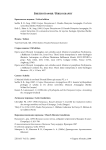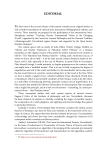Schole. Философское антиковедение и классическая традиция @classics-nsu-schole
Статьи журнала - Schole. Философское антиковедение и классическая традиция
Все статьи: 733
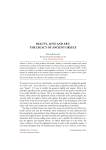
Beauty, love and art: the legacy of ancient Greece
Статья научная
There is a deep problem with beauty. Beauty is commonly equated with sexual attractiveness. Yet there is also the beauty of art, which arouses an aesthetic response of disinterested contemplation. As Roger Scruton writes in his recent book, Beauty (2009): “In the realm of art beauty is an object of contemplation, not desire.” Are there, then, two kinds of beauty? By looking back at the classical Greek conception of beauty, we may see how it gave rise to the modern dilemma, and some possible ways of resolving it.
Бесплатно
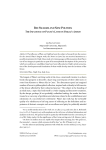
Bee Swarms and New Polities: The Influence of Plato’s Laws on Virgil’s Aeneid
Статья научная
The influence of Plato on Virgil has been the subject of research into the sources for the Aeneid. Plato’s longest work, the Nomoi or Laws, has not received attention as a possible inspiration for Virgil. Close study of certain passages will demonstrate that Plato’s use of bee imagery in particular as part of his metaphorical description of the process by which new polities are established may have been influential on Virgil’s artistic presentation of the development and foundation of what would develop into the Lavinium of the future.
Бесплатно
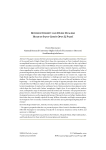
Between eternity and divine dualism: Hugh of Saint-Cher’s Opus II, pars I
Статья научная
The paper contains the the first Latin transcription and an English translation of the first part of the second book of Hugh of Saint-Cher's Opus, his commentary on Peter Lombard's Sentences accomplished between 1231 and 1234. The transcription is based on the codex Vat. lat. 1098 collated with five auxiliary manuscripts. In line with William of Auxerre and Alexander of Hales Hugh critically disavows pagan and heretical stances represented by Plato, Aristotle, Epicurus, and Manichean regarding the creation of the world. My foreword sheds light on the philosophical value of presented arguments plus the historical background of the issue and Hugh's relation with contemporary theologians whose ideas Hugh rearranges and modifies in one concise text. I argue that Hugh blends together these four authorities to challenge and reject the concepts of eternity and dualism. The theologian imputes dualism - contrary to the run-of-the-mill attribution of three beginnings - to the Stagyrite while putting the concept of opposite principles from Aristotle referenced before by William in Cathar's mouth. Even Plato and Epicurus become proponents of the heretical repudiation of creation from nothing in favor of divine production from adjacent matter which aligns the Greeks with Cathars' metaphysics. Hugh's Opus, if not original in the modern sense, anticipated a surge of refutations aimed at heretics and “Averroists”. The proposed isomorphism between Aristotle-Heretic and Cathar-Peripatetic partially molded early arguments in the theological Sentences as well as inquisitorial Summa. Whereas the focus on Сathars' dualism diminished when they were brutally wiped off the map, William, Alexander, and Hugh's reasons against the Peripatetic view on eternity continued to draw attention among theologians fighting back “Averroism”.
Бесплатно
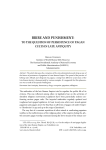
Bribe and punishment: to the question of persistence of pagan cults in late antiquity
Статья научная
In this article, the corruption of the state apparatus and the clergy of the late Roman Empire is seen as one of the factors of the prolonged preservation of paganism in the Christian empire. A number of examples illustrating the facts of giving bribes to pagans in order to preserve their rights to the administration of ancient cults in the provinces of Thebaida, Egypt, Phenicia of Lebanon, Palestine, Osroena, Sardinia in the 4th-6th centuries are cited. The article suggests that this phenomenon was a consequence of the approval of the institution of suffragia.
Бесплатно
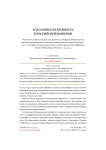
Classical antiquity in the Russian empire
Рецензия
A review on an annotated bibliography of the works dedicated to Antiquity, published in the Zhurnal ministerstva narodnogo prosveshcheniya from 1834 to 1917, prefaced, collected and annotated by A. I. Ruban and E. Yu. Basargina. St. Petersburg, 2015.
Бесплатно
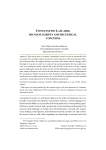
Constantine Lascaris, his manuscripts and his ethical concerns
Статья научная
This article aims to examine Constantine Lascaris’s work on Aristoteles’ ethical corpus. We consider evidence from the textual witnesses of the Nicomachean Ethics, the Eudemian Ethics, the Magna Moralia, and some other minor ethical writings, which belonged to Lascaris, in order to reconstruct his working methods. We also explore Lascaris’ own statements about virtuous life; a life devoted to the service of the common good, to philosophy and to the study of texts. For him philosophy was a way of life, rather than simply a discourse. We look at the link between written culture and philosophical life and propose further research into how Byzantine and Renaissance scholars understood their own intellectual activities to be a special kind of spiritual exercise intended to promote moral improvement in both individuals and societies.
Бесплатно
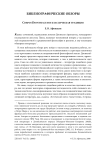
Corpus Dionysiacum и классическая традиция
Статья обзорная
Два библиографических обзора, посвященные Дионисийскому корпусу . В первом обзоре кратко рассматриваются недавние работы, посвященные проблеме неоплатонических источников корпуса. Эта тема будет продолжена в следующем выпуске. Во втором обзоре дается очерк славянской традиции бытования корпуса. Этот текст публикуется по-английски, поскольку до настоящего времени не выходило ни одной обобщающей работы по этой теме на английском языке.Two bibliographic summaries are dedicated, respectively, to the Dionysian corpus and the classical tradition and Dionysius the Areopagite in the context of Byzantine-Slavonic literary relations. The former outline is in Russian and it will be continued in the next issue (this time focused in the Christian sources of Pseudo-Dionysius), while the latter is prepared in English, since no detailed outline of this subject is available in English so far.
Бесплатно
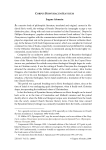
Статья обзорная
Two bibliographic summaries are dedicated, respectively, to the Dionysian corpus and the classical tradition and Dionysius the Areopagite in the context of Byzantine-Slavonic literary relations. The former outline is in Russian and it will be continued in the next issue (this time focused in the Christian sources of Pseudo-Dionysius), while the latter is prepared in English, since no detailed outline of this subject is available in English so far.
Бесплатно
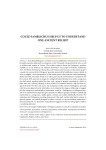
Could Iamblichus help us to understand one ancient relief?
Статья научная
Describing Pythagoras’ activities in Croton Iamblichus summarizes the content of his public speeches addressed to young men, to the Thousand who governed the city, as well as children and women of Croton. The earliest evidences about the Pythagoras’ speeches, available to us are found in an Athenian rhetorician and a pupil of Socrates Antisthenes (450-370 BCE), the historians Dicearchus and Timaeus, and Isocrates. In the present paper I consider the content of the Pythagoras’ speeches, preserved by Iamblichus, in more details, in order to suggest a new interpretation of the famous grave relief from the Antikensammlung, Berlin (Sk 1462). The relief, found in an “Olive grove on the road to Eleusis” and dated to the first century BCE, presents an image of a sitting half-naked bearded man with a young man, also half-naked, standing behind his chair, and a group of peoples consisting of a child, an older man and a woman, standing in front of him. Our attention attracts a big and clear image of the letter ‘Psi’ above the scene. The comparison of the content of Pythagoras’ speeches with the scene depicted on the relief allows us to interpret the image as following: we suggest that the sitting man, undoubtedly a philosopher, could be a Pythagorean or Pythagoras himself; he is attended by his pupil and gives speeches to different groups of peoples, symbolically represented as a young man, a public agent, a woman and a child. Admittedly, the letter ‘Psi’ symbolizes the Pythagorean teaching about psyche (the soul), and the relief itself, contrary to general opinion, was initially designed to adorn a school or a private building rather than a funeral monument. An alternative interpretation suggested is that the sitting figure could be a wandering physician.
Бесплатно
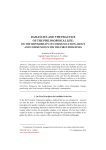
Статья научная
This paper is an overview and introduction to the key elements of Damascius’ philosophy. I examine the attributes and the relationship between the Ineffable, the One, and the All as the cornerstones of his theoretical system. I then investigate the role of this system of thought for Damascius and his contemporaries as a guide to the philosophical life and its repercussions for attaining the highest principles. Is contemplation possible or are other means needed, such as theurgy and purification of the soul? Does the philosopher occupy a privileged position in this system, as in the preceding Platonic tradition or is the philosopher’s position different, by the experience of void and the inability to speak about and grasp the ‘nothingness’ of the highest principles?
Бесплатно
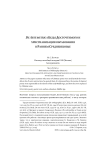
De arte metrica беды досточтимого и христианизация образования в раннем Средневековье
Статья научная
В статье показано, какие тексты христианских поэтов Беда Досточтимый использовал при написании De arte metrica , как он их цитировал и привлекал; демонстрируется, каким образом в образовательном процессе раннего Средневековья происходило вытеснение существующих норм классического стиха и их замена на христианские.
Бесплатно
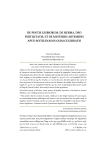
Статья научная
Статья завершает исследование эротического ритуала предсвадебных мистерий Артемиды в античной Митилене и его отображения в поэзии Сапфо и Алкея. Девушки-невесты либо новобрачные, проходя посвящение в мистерии Артемиды, приносили в жертву Артемиде свою девственность (ср.: Sapph. Fr. 99 (a-b), Sapph. Fr. 114 Campbell; SEG XX 717, 84-97; IG XII (2) 255; Ps.-Aeschin. 10 и др.). При этом старшие девушки в ходе этого ритуала, по-видимому, выступали в образе Гермеса, фаллического божества плодородия (ср. Sapph. Fr. 141, Sapph. Fr. 150 Campbell; TAM III/1 35, A1). В пользу такой интерпретации свидетельствует сопоставительный анализ данных археологии, эпиграфики и литературной традиции.
Бесплатно
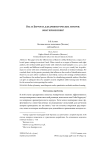
Delta Берроуза для древнегреческих авторов: опыт применения
Статья научная
В этой статье предпринята попытка эмпирически оценить эффективность метода измерения стилистической разницы, известного как Delta Берроуза, на материале древнегреческого корпуса. Эксперимент с корпусом из четырнадцати (и затем восьми) авторов подтвердил общую эффективность метода. Даже на небольших выборках в 1000–5000 слов решения Delta по большей части корректны, а ее ошибки связаны в основном с текстами, близкими в жанровом отношении. Именно жанровое сходство в обучающей выборке, а не количество слов или длина отрывка, оказывает наибольшее влияние на результат классификации. В спорных случаях, особенно если нет возможности использовать отрывки большей длины (10 000 слов и больше), составление шорт-листов предпочтительнее, чем назначение единственного кандидата. Подобные шорт-листы дают адекватное представление о ближайших стилистических соседях испытуемого текста, оставляя свободу исследователю в интерпретации результатов.
Бесплатно
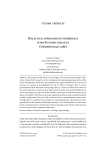
Dialectical approaches of temperance in the platonic dialogue “Charmides” (157c-158e)
Статья научная
The purpose of this article is to investigate how the discussion in Plato’s “Charmides” is formed with respect to a) the ontological and epistemological approaches of the virtue of temperance and b) how the transition from a general definition of a virtue to its presence to a person is accomplished. After a concise presentation of those discussed in the passage 156d-157c, where we follow Plato’s views on the soul to that time, we focus on how dialectics between Socrates and “Charmides” develops in the passage 157c-158e. Our article includes, apart from an introduction and an epilogue, two chapters. The first one is mostly analytical and the second is mainly formed by synthetic judgements. They are both crucial mostly for methodological reasons, since through them we can follow how temperance turns gradually into a question to be investigated and how the Athenian philosopher attempts to set the foundations of a discussion based on rational reason with the main reference focusing on the criteria which someone can use to prove that he possesses temperance.
Бесплатно
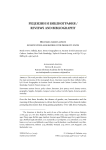
Discussing various aspects of erotic ethno-geographies of the Greek city-states
Рецензия
The work provides a brief description of the content and a critical analysis of the main provisions of the monograph by an American researcher Kate Gilhuly: Gilhuly K. Erotic Geographies in Ancient Greek Literature and Culture. London; New York: Routledge, Taylor & Francis Group, 2018.
Бесплатно
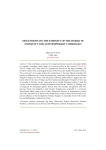
Discussions on the eternity of the world in antiquity and contemporary cosmology
Статья научная
This contribution continues the comparison between ancient and modern beliefs on scientific cosmology which began in a previous article in this Journal (ΣΧΟΛΗ 5.2 [2011]). I begin with a brief survey of contemporary theories on Big Bang cosmology, followed by a study of the cosmological theories of the Presocratic thinker Pherecydes of Syros. The second part of my paper studies the ramifications of the basic Platonic principle that bonum est diffusivum sui. I begin by studying the vicissitudes of this theory in the Patristic thought of Origen, the Arians, and Athanasius. Following Willy Theiler, I suggest that similarities between the views of Origen and the Neoplatonist philosopher Porphyry of Tyre may be traceable to Plotinus' teacher Ammonius Saccas. Finally, following Endress, I study the way the Arabic translation of some propositions from Proclus' Elements of Theology were accompanied by interpolated glosses derived from the Christian Neoplatonist John Philoponus, which were designed to make Proclus' thought more acceptable to a creationist, Monotheistic belief system such as Islam. Philoponus' theories of instantaneous creation were taken up, thanks to al-Kindi, by the Neoplatonica Arabica, whence they exerted an important influence on the development of Islamic thought. An Appendix of texts with translation and bibliography completes the article.
Бесплатно
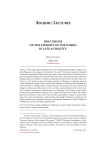
Discussions on the eternity of the world in late antiquity
Статья научная
This article studies the debate between the Neoplatonist philosophers Simplicius and John Philoponus on the question of the eternity of the world. The first part consists in a historical introduction situating their debate within the context of the conflict between Christians and Pagan in the Byzantine Empire of the first half of the sixth century. Particular attention is paid to the attitudes of these two thinkers to Aristotle's attempted proofs of the eternity of motion and time in Physics 8.1. The second part traces the origins, structure and function of a particular argument used by Philoponus to argue for the world's creation within time. Philoponus takes advantage of a tension inherent in Aristotle's theory of motion, between his standard view that all motion and change is continuous and takes place in time, and his occasional admission that at least some kinds of motion and change are instantaneous. For Philoponus, God's creation of the world is precisely such an instantaneous change: it is not a motion on the part of the Creator, but is analogous to the activation of a state (hexis), which is timeless and implies no change on the part of the agent. The various transformations of this doctrine at the hands of Peripatetic, Neoplatonic, and Islamic commentators are studied (Alexander of Aphrodisias, Themistius, al-Kindi, al-Farabi), as is Philoponus' use of it in his debate against Proclus.
Бесплатно
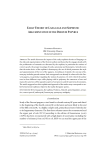
Early Theory of Language and Sophistic Argumentation in the Derveni Papyrus
Статья научная
The article discusses the impact of the early sophistic theories of language on the style and argumentation of the Derveni author and shows that he engages deeply with the problematics of semantics as discussed by the sophists, in particular the notions of correct speech, the proper meanings of words, synonymy and homonymy. Aristotle notes that the main device of the sophists is homonymy, the use of which permeates the style and argumentation of the text of the papyrus. According to Aristotle, the concept of homonymy includes general notions. Such an approach can already be observed in the Derveni papyrus, in particular regarding the notion of sameness (τὸ αὐτό) which the author uses in three different ways while playing with its polysemy: the sameness of one and many, the sameness of the opposite aspects of one process and the sameness of synonyms. The article suggests how this sophisticated approach of the author may correspond to earlier hermeneutic traditions related to the orphic theogonic poems.
Бесплатно

